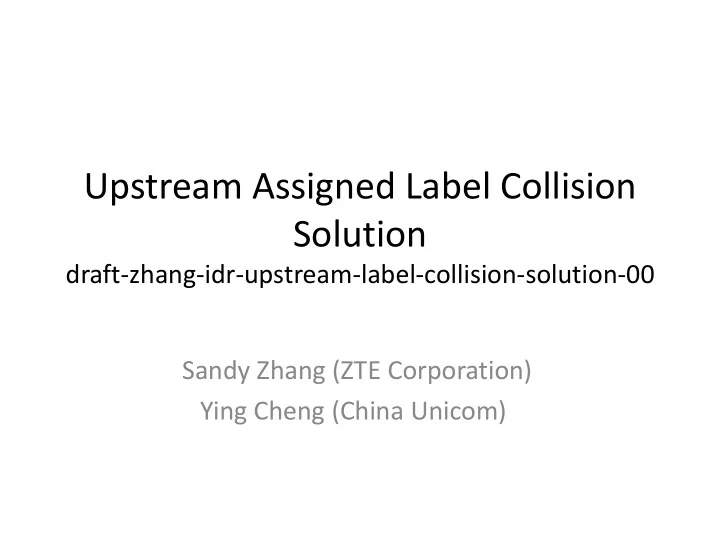

Upstream Assigned Label Collision Solution draft-zhang-idr-upstream-label-collision-solution-00 Sandy Zhang (ZTE Corporation) Ying Cheng (China Unicom)
Problem Statement (VPN1,S1,G1) Label: 10 VPN1 PE1 sender1 VPN1 receiver1 VPN2 PE3 receiver2 VPN2 PE2 Which one will be the valid? sender2 (VPN2,S2,G2) Label: 10 Label: 10 Forward to: receiver1 receiver2 Label: 10 Forward to: receiver1 Label: 10 Forward to: receiver2
Problem Statement Why do the collision happen? • In present network, the network administrator must allocate the label space on every PE in advance. • There are tens of PEs in one domain. • The network is developing. The MVPN and DC will consume a great number of upstream-assigned labels. -------The numbers of MVPN S-PMSIs will become larger. -------The BUM of DC may consume more upstream-assigned labels. • If the label space that is reserved on every PE is large, then many labels may be waste. • If the label space that is reserved on every PE is small, then some PEs will use up all its labels. • The network administrator adjust the label space on every upstream PEs. The adjustment is not foreseeable and consume large manpower.
Solution The algorithm: • Each upstream PE advertise routes with the timestamp attribute. • When downstream PEs finds that there are two upstream PEs advertise routes with a same upstream-assigned label: ------The downstream PEs choose the route with the earlier timestamp to be valid. • All the PEs include upstream and downstream PEs will receive the routes. ------The upstream PEs that advertise route with later timestamp will adjust the label. • Tie-Break ------If two upstream PEs advertise route with same timestamp, we make the tie-break on the IP-address of upstream PEs.
Advantage of solution • Why we use timestamp to describe the route? ------Someone may think that we may use the local-preference/MED/cost and so on. • The timestamp will mark the origination time of the routes. • The routes which have been originated early should have more priority. • The method will improve the network stability.
• Comments welcome
Thanks!
Recommend
More recommend